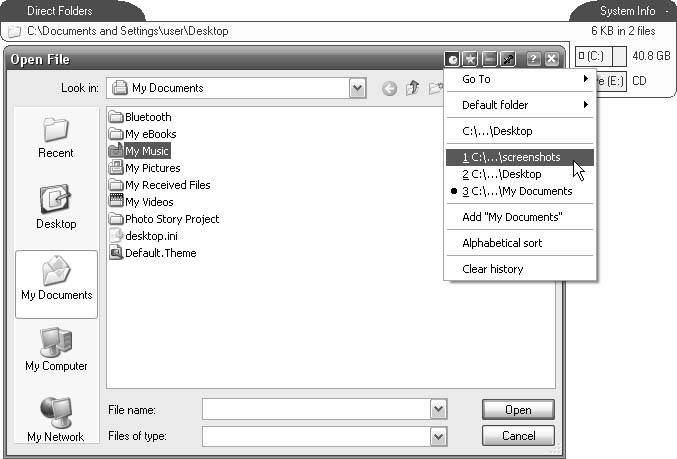Section 2.3. FILE DIALOGS
2.3.1. Customize File DialogsTHE ANNOYANCE: The folders listed in the gray bar along the left side of most File THE FIX: Absolutely, but as you've undoubtedly figured out, you can't do it from within the file dialogs themselves (except in Microsoft Office applications, as discussed later in this fix). If you have Windows XP Professional or Media Center Edition, open the Group Policy Editor (go to Start Figure 2-16. Use the Group Policy Editor to customize the Places bar in file dialogs.
Click OK when you're done. Your custom Places bar will appear in the file dialogs in most of your applications right away, although you'll need to restart any running applications to get them to recognize your changes. The big exception is Microsoft Office applications, which use nonstandard dialogs. Microsoft saw the need to allow users to customize the Places bar, but only made it easy in Microsoft Office applications (Versions 2002 and later). In the File Note: Want to keep some of the default folders in the Places bar? Just type in their special code names, such as Recent (for My Recent Documents), Desktop, MyDocuments, MyComputer, and MyNetworkPlaces. You can also display other special folders by entering their code names, such as CommonDocuments, CommonMusic, CommonPictures, MyFavorites, MyMusic, MyPictures, Printers, and ProgramFiles. (The so-called "common" folders are special shared folders used by multiple users on the same machine.) If you have Windows XP Home Edition, or you just want a friendlier interface than the Group Policy Editor, you can use Creative Element Power Tools (http://www.creativelement.com/powertools/) to configure your Places bar in all parts of Windows, including Microsoft Office apps. 2.3.2. List Recently Used FoldersTHE ANNOYANCE: I often find myself working on the same projects every time I turn on my computer, but the File THE FIX: The default folder is actually decided by the application you're using, so you might find that some programs automatically open the folder you used last, while others send you back to My Documents. Regardless, you can enhance your file dialogs with some nifty shortcuts. Note: You can try clicking the Recent folder (sometimes labeled My Recent Documents) in the Places bar (see "Customize File Dialogs," but this only shows the most recently opened documents, not the folders that contain them. There are a handful of different programs designed to augment or enhance file dialogs. Perhaps the fanciest example is Direct Folders ($24.95, http://www.codesector.com), which not only lists the folders you've recently accessed with the file dialogs in each of your applications, but decorates the dialog windows with other tools as well (see Figure 2-17). After installing Direct Folders, just click the star icon in the title bar to list your recently visited folders, plus favorites, and even the folder currently displayed in the topmost Explorer window. If you want a more minimalist approach to file dialog enhancement, Creative Element Power Tools (http://www.creativelement.com/powertools) adds quick access to recently-used folders with a much simpler interface. Figure 2-17. Use Direct Folders to augment your file dialogs with a list of recently used folders, plus other useful tools.
It also saves the size and view settings (Details, icon, etc.) of your file dialogs, and can show the full path of the current folder right in the dialog title bar. Another program that works similarly is FileBox eXtender ($20; http://www.hyberionics.com). All three companies offer free, fully working demos of their tools. |
 Open and File
Open and File 






